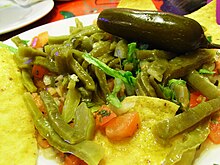We and our guests, Ian, Mint, and Mint's 13 year old daughter Rachel survived a week together on Ladybug.
 |
| Mint and Ian climb the trail at Isla San Francisco |
The good - lots of wildlife sightings including schools of jumping rays, porpoises, and colourful reef fish. We had a good if somewhat challenging hike on Isla San Francisco as well as an expedition to see the 100 year old pearl farm on Isla Espiritu Santo (Click
here for more info on this farm). We also had some excellent sails, having little occasion to run the motor.
 |
| Rachel and Rani on Isla San Francisco. The Sierra Giganta mountains on the Baja are in the background. |
 |
| Rachel looks happy with her own creation for lunch. |
The not so good - Captain Curmudgeon's water rationing was not easy for Mint and Rachel who both have long hair. My offer to cut their hair with the number 4 attachment on my trimmer was not well received... We did our dishes in salt water and everyone was so careful with the water (being frightened by Captain Curmudgeon) that we came back with our tanks still partly filled. Fortunately we brought along plenty of tequila and juices to supplement our supply of drinking liquid.
 |
| Rani at the pearl farm on Espiritu Santo island. |
 |
| Chris holds an oyster shell. In the background are piles of shells and the pearl culture raceways built out of un-mortared stone. |
We had some rough nights at anchor with the local Corumel winds making most of the anchorages noisy and a little bouncy. These winds are a fact of life in the islands north of La Paz, but they seemed particularly strong this time out. Mint and Ian were sleeping in the V berth near the anchor and were subjected to a bouncier and noisier ride than Rani and I who had the smaller quarter berth further aft. Rachel had the berth over one of the water tanks, which would slosh around when things got rough, so she lost some sleep too and had to move onto the settee across from this berth one night.
 |
| Annie under sail with Chris at the helm. |
 |
| Ian sailing Annie in Caleta Partida |
Ian enjoyed the sailing and we had some decent sailing breezes on 5 out of the 7 days. Ian has sailed with me before and both he and Mint have taken sailing courses, so they know enough to be helpful crew. Ian also enjoyed sailing little Annie in the Caleta Partida anchorage. Mint and Rachel were good sports, and despite feeling a bit queasy at times during the first few days they did not complain.
 |
| Adolescent frigate birds in the mangroves near the pearl farm. |
 |
| More immature frigates. |
Privacy can be a bit of a challenge on our smallish boat, especially when the head has a curtain for a door, so it was no surprise that bodily functions that do not usually get discussed were a topic of conversation most days, especially with a 13 year old on board.
 |
| Ian enjoys a nice 10 knot breeze on our last day out. |
Hopefully it was a positive experience for all and we have learned a few things for the next time we host friends on board.



















































